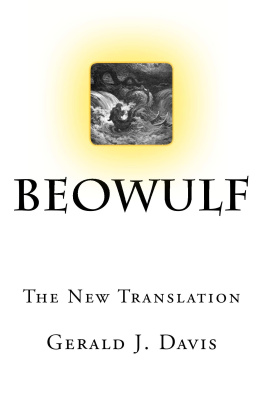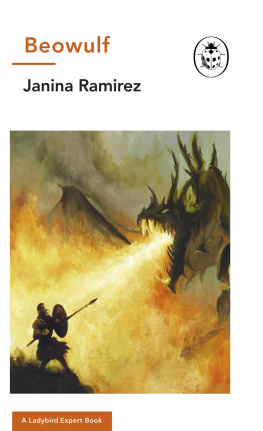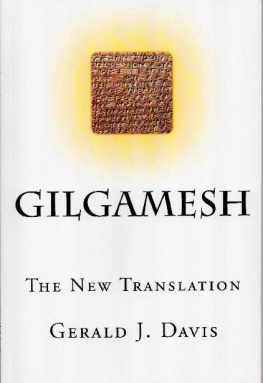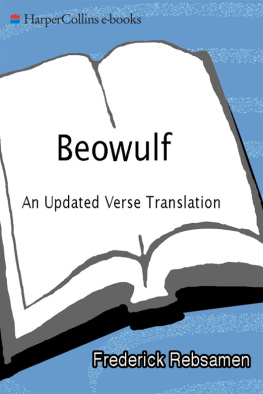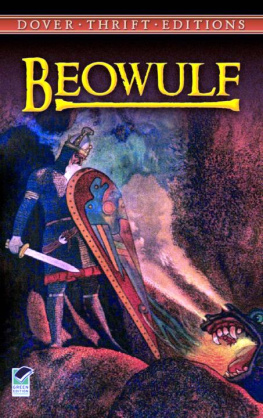Beowulf
The New Translation
Gerald J. Davis
Insignia Publishing
Translation copyright 2013 by Gerald J. Davis
All rights reserved. No part of this book may be reproduced, stored in a retrieval system or transmitted in any form or by any means, graphic, electronic or mechanical, without the prior written permission of the publisher, except by a reviewer who may quote brief passages in a review to be printed online, in a newspaper, magazine or journal.
ISBN: 978-1491250181 (Softcover)
ISBN: 978-1-304-30491-9 (Hardcover)
Insignia Publishing
Bridgeport, Connecticut
For Peter and Jennifer
Also by Gerald J. Davis
Don Quixote, The New Translation
Left No Forwarding Address
Jungle of Glass
A Murder Too Personal
Contents
A Note on the Translation
By
Gerald J. Davis
J. R. R. Tolkien, in his famous 1936 lecture, Beowulf: The Monsters and the Critics, said of Beowulf, It is a work of genius, rare and surprising in the period, and it is worth studying. ( Beowulf ) is a poem by an Englishman using, afresh, ancient and largely traditional material. The high tone, the sense of dignity, alone, is evidence in Beowulf of the presence of a mind lofty and thoughtful. In Beowulf we have an historical poem about the pagan past. It is a poem by a learned man writing of old times who, looking back on the heroism and sorrow, feels in them something permanent and something symbolical
Beowulf is not an actual picture of historic Denmark or Geatland or Sweden about A.D. 500. But it is, on a general view, a self-consistent picture, a construction bearing clearly the marks of design and thought. The whole must have succeeded admirably in creating, in the minds of the poets contemporaries, the illusion of surveying a past, pagan but noble, and fraught with a deep significancea past that itself had depth and reached backward into a dark antiquity of sorrow.
We may be thankful that the product of so noble a temper has been preserved by chance (if such it be) from the dragon of destruction.
[Here Tolkien is referring to the Cotton Library fire in 1731 which burned parts of some edges of the only extant copy of the Beowulf manuscript.]
Beowulf is, indeed, the most successful Old English poem because, in it, the elements of language, metre, theme, structure are all most nearly in harmony.
If the funeral of Beowulf moved once like the echo of an ancient dirge, far-off and hopeless, it is to us as a memory brought over the hills, an echo of an echoIt is written in a language that, after many centuries, still has essential kinship with our own. It was made in this land, and moves in our northern world beneath our northern sky, and for those who are native to that tongue and land, it must ever call with a profound appealuntil the dragon comes.
Tolkien devoted a major part of his academic life at Oxford to the study of Beowulf and, almost singlehandedly, through his efforts, brought this oldest and longest Anglo-Saxon epic poem to the publics attention after centuries of neglect. Tolkien, indeed, wrote a translation of and commentary on Beowulf , which remain, unpublished, to this day, among the archives of the Bodleian Library at Oxford. It is certain that this epic served as a significant inspiration for Tolkiens later works, such as The Hobbit and The Lord of the Rings.
The origins, history and authorship of Beowulf are shrouded in uncertainty. It is fairly clear that the events depicted in the story take place during the late fifth to early sixth century A.D., because there is historical evidence that King Hygelac of the Geats was killed in a battle in France between the Geats and the Franks about 516-521 A.D. Certain other personages named in the poem, such as Ohthere, Eadgils and Ongentheow have been proven to be real historical figures and we can date them with some degree of confidence.
This heroic epic probably began, as most do, with a wandering troubadour strumming a stringed instrument, sitting before a hearth-fire, and singing the verses to a spellbound audience arrayed before him. At some point, the words of the troubadour were written down in a manuscript form, in order to preserve the story for posterity. There is great dispute among scholars as to when the manuscript itself was actually transcribed. Tolkien believed it was written about the eighth century, while other serious experts assert it was written as late as the early eleventh century.
As stated earlier, there is only one manuscript of Beowulf in existence. It is known as the Nowell Codex and is to be found in the British Library. The manuscript was evidently written by two distinct scribes, because the first 1939 lines are written in one handwriting and the remaining 1243 are written in another. Both scribes took meticulous care in transcribing the material, and their painstaking efforts are immediately evident to the diligent observer. However the provenance and subsequent ownership of the manuscript are unknown until it appeared in the library of Laurence Nowell (1515-1571), a tutor to Edward de Vere, 17 th Earl of Oxford (1550-1604). The manuscript then made its way to the library of Robert Bruce Cotton, 1 st Baronet of Connington (1570-1631), where it was damaged by a fire in 1731, when the edges of the manuscript were singed and the pages shriveled. The Beowulf manuscript, together with the rest of the impressive collection of the Cotton Library, was donated by a descendant of Robert Bruce Cotton, Sir John Cotton, to the nation of England, and it is now housed in the British Library, where it is designated as Cotton Vitellius A.xv. The first actual reference to the manuscript appeared between 1628 and 1650 and was written by Franciscus Junius, the Younger (1591-1677), a collector of old manuscripts.
Subsequently, there appeared two catalogs of the contents of the Cotton Library. The first, in 1696, was assembled by the Reverend Thomas Smith (1638-1710), who was in charge of the Library for twelve years. The second was compiled by Humfrey Wanley (1672-1726), and the first official recorded notice of the manuscript appeared in his 1705 Catalog of Anglo-Saxon Manuscripts.
Portions of Beowulf were first published in English in 1805 by the historian Sharon Turner (1768-1847), and he deserves full credit for bringing to the attention of the English people the importance of this heroic elegy.
The first complete translation of Beowulf was written by Grimur Jonsson Thorkelin (1752-1829), an Icelandic scholar employed by the Danish civil service, and was published in 1815. Thorkelins translation was written in Latin and it contained numerous textual errors which were uncovered by experts in later years.
An early translation of Beowulf which received high praise from academics was the 1837 prose version written by John Mitchell Kemble (1807-1857). It was lauded for Kembles extensive scholarship and for its faithfulness to the original. Another important and highly-regarded verse translation of Beowulf was published in 1892 by John Lesslie Hall (1856-1928).
The poetical device employed in Beowulf is not rhyme, but alliteration, the rhythmic repetition of initial sounds of the words. Each line is divided into two parts separated by a pause, called a caesura. There are four beats in each line; that is to say, two beats in each half-line.
These are the opening lines of Beowulf :
HWEAT WE GARDE-na in gear dagum
theod cyninga thrym ge-frunon
hu tha aethelingas ellen fremedon.
This may be roughly translated as:
Hark! The Spear-Danes, in earlier days,
King of the people, power we have heard of,
how the Princes, deeds of valor accomplished.
Several other poetic devices are used in this work, such as kennings, which are compound-word metaphors like whale-road for the sea and heavens candle for the sun, and this is common to many classic Old English poems.
Next page
